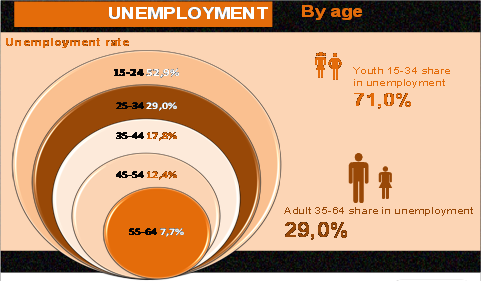WHAT IS IT?
Youth unemployment refers to the share of labor force ages 15-24 without work but available for and seeking employment. There are many reasons why youth unemployment is available or present in the world, but it is high and low in some countries and there are also measures to eradicate it.

Youth unemployment rate by ages
REASONS OF YOUTH UNEMPLOYMENT
Youth unemployment is a global issue, with varying levels of undesirable conditions across countries. Unemployment is often categorized under particular groups such as; ethnic minorities, high school dropouts, and individuals of poorer areas. These individuals definitely lack experience and this might or be the major reason behind youth unemployment. The unbelievable fact is that youth unemployment is considerably higher than unemployment among adults and it has being like this throughout the last two decades, and the reason for this is that youths usually have lower job protection. The skill mismatch issue is another reason or cause of youth unemployment and it is particularly important in the developing world.
DEFINITION OF A CAMPAIGN AND ITS PROCESS
A campaign was created about youth unemployment which was one of our semester task for Professional Practice course. In addition, I would like to briefly define what is a campaign for better understanding of this blog. A campaign is any series of actions or events that are meant to achieve a particular result, for example, an advertising campaign of television commercials. The campaign task was given to groups with five to seven members in each group. The main aim of this campaign was to recruit young individuals who are unemployed and looking for an opportunity to make a difference within their community. My group and I organised a campaign in order to create more awareness in local communities and in areas such as shopping malls and more importantly busy areas. We visited the Alexander township and did our best to create awareness about youth unemployment. A Facebook page and a special event was specifically created for this campaign in order to encourage stakeholders engagement. These stakeholders are the individuals that will help to eradicate this issue of youth unemployment by providing learnership programs for dropout youths and the less privileged ones.
For the duration of this campaign and working with my fellow classmates has improved my Public Relations skills in many aspects such as writing, media engagement, client or stakeholder relationship management, campaign development and strategy. In terms of the above mentioned Public Relations skills, my writing techniques for media releases and pitch letters for example has improved to the next level wherein I am more comfortable with the layout and choosing the right organization for delivery.
In order to understand the process of media engagement, client or stakeholder relationship management and campaign development, an individual must know and have knowledge of how each process works. During the campaign, working with my group also helped a lot to develop my teamwork spirit and gained more understanding about Public Relations activities. Media engagement expects an individual to know the various media platforms, when to use them effectively and how they work. During the campaign, it was obligatory that we use Facebook to create awareness of youth unemployment. In the process of creating this page, I learnt new things such as how to create a page for advertising purposes. Dealing with client or stakeholder relationship management, it is very important to know your stakeholder individually by name but not in general. It is also vital to know their needs and how to attract them. Campaign development entails a lot such as, knowing your target market, choosing the right platform for your messages to your target market and also there must be aim and objectives for your campaign. The last aspect is strategy, and this entails the overall planning of an activity and in this situation, it involves having ideas and how to plan for a campaign. The step by step process involved is necessary in order to carry out a successful campaign.









